#hypo masque corn snake
Text

#snake#snakes#reptile#reptiles#reptiblr#corn snake#corn snakes#corn snake morphs#baby snake#psd23#psd23f8#hypo masque corn snake
64 notes
·
View notes
Text


Meet Frumpkin! She's a hypo masque corn snake produced by the wonderful @omg-snakes ; she has a little kink in her spine, so she's never going to be bred. Her job is to be sweet and beautiful and eat rodents, and she's already doing the first two for me. :3
#frumpkin the snake#corn snake#pantherophis guttatus#snek#snakes#reptiles#reptiblr#pets#animals#meatspace#cute#please don't come for me about the state of my bedroom i have limited time and even more limited spoons
80 notes
·
View notes
Text

First of the pairings this year for our corn snakes. It's the first year for the male, Zeus, who is suspected to be some kind of Motley. We are testing out his genes against our experienced female, Momma.
Momma has been bred the last two years and despite being Anery has produced Hypo, Normal, Masque, and Amel. Basically she has produced all the "red" babies every year.
We don't know what this pairing will bring but are excited to further test Momma's genes and see what Zeus can do.
7 notes
·
View notes
Photo

Quirk - Corn Snake (Hypo Masque) - Pantherophis guttatus
#quirk#corn snake#mine#hypo masque corn snake#masque corn snake#hypo corn snake#pantherophis guttatus#snake#reptile
106 notes
·
View notes
Text


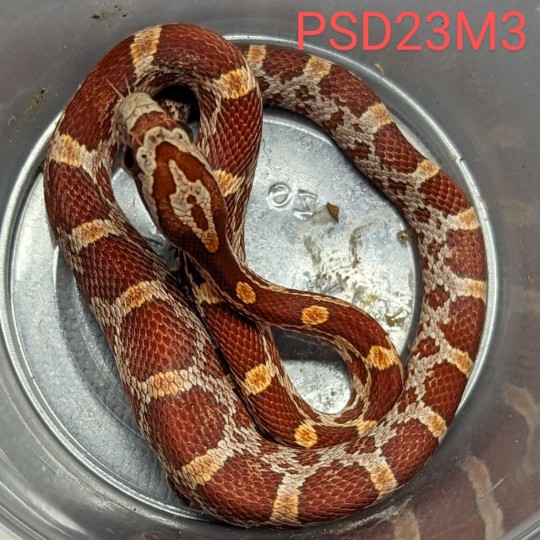




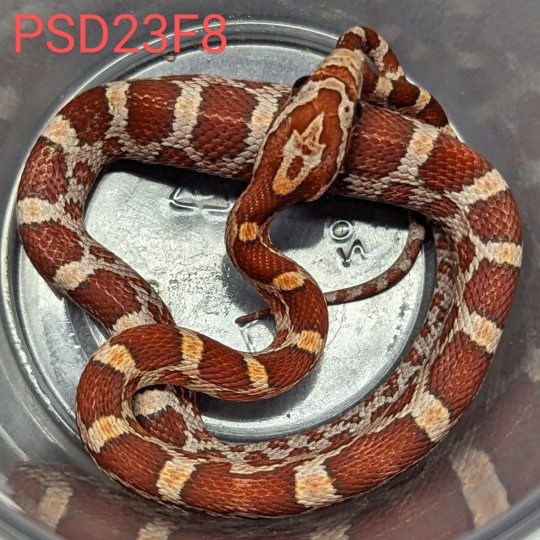


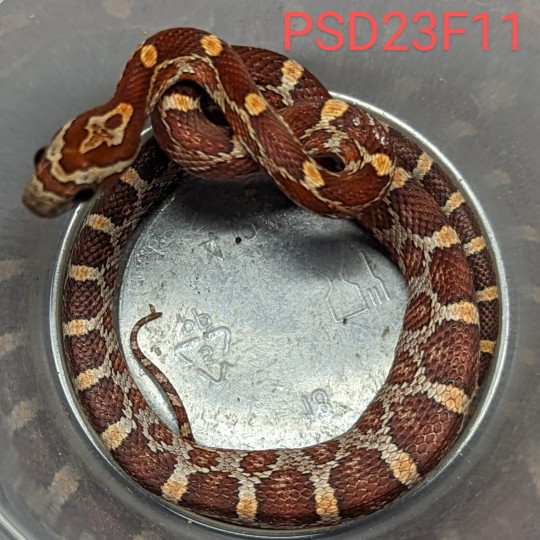



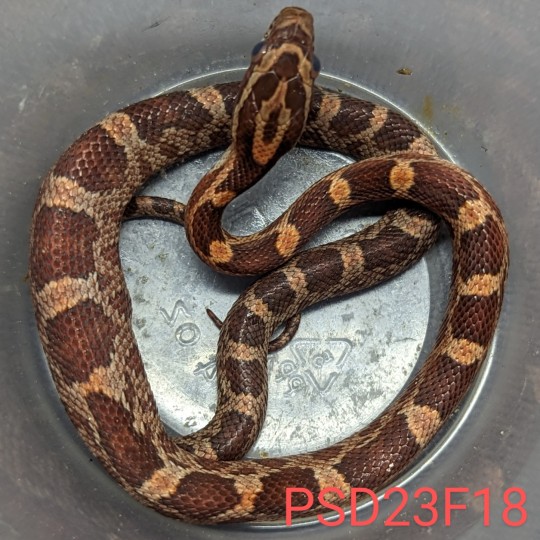
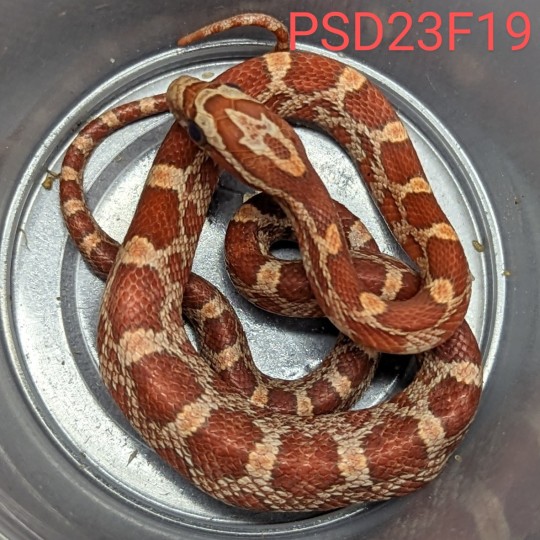
PSD23 is definitely showing some red-enhancing trait that I'm assuming is from their mom Pumpkin Spice. I was already planning to sit on a few of these to give some genetic diversity to my Cinder line, but getting to see how their reds develop is a cool bonus.
#PSD23#psd23 ref#snake#snakes#reptile#reptiles#reptiblr#corn snake#corn snakes#baby snake#corn snake morphs#classic masque corn snake#hypo masque corn snake#hypo diffused corn snake
48 notes
·
View notes
Text

SOFT PRETZEL
#psr22#psr22m11#hypo masque corn snake#snake#snakes#reptile#reptiles#reptiblr#corn snake#corn snakes#baby snake
224 notes
·
View notes
Text

#carl#snake#snakes#reptile#reptiles#reptiblr#corn snake#corn snakes#hypo corn snake#hypo masque corn snake
70 notes
·
View notes
Text

Carl is the most photogenic snake I've ever met. He poses like a model, holds perfectly still while I snap photos, and will even sometimes let me adjust him slightly.
Total himbo.
#broad of chest#pure of heart#dumb of ass#carl#snake#snakes#reptile#reptiles#reptiblr#corn snake#corn snakes#hypo masque corn snake#probably something red-enhancing in there too#Hypo corn snakes
87 notes
·
View notes
Text

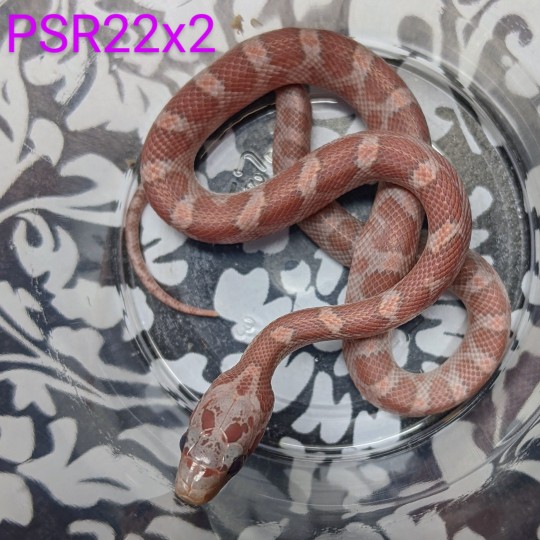

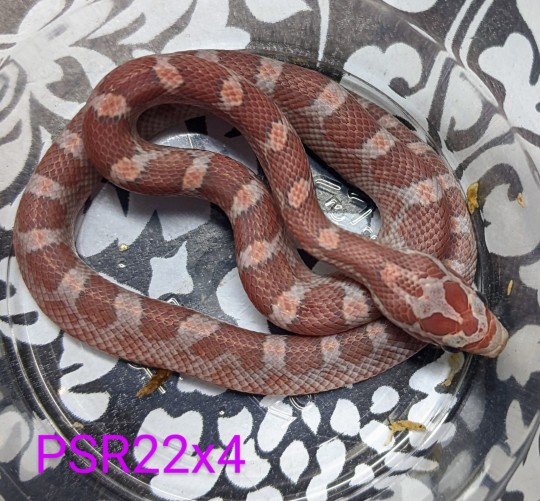




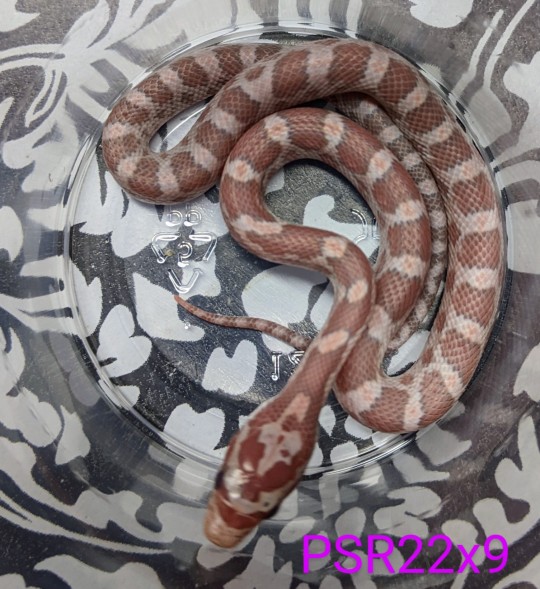
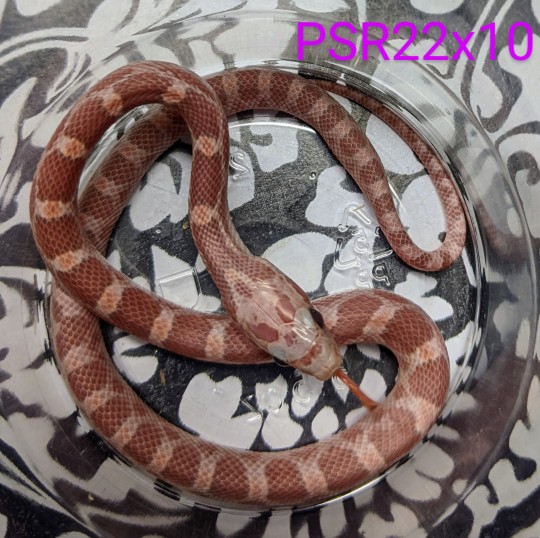




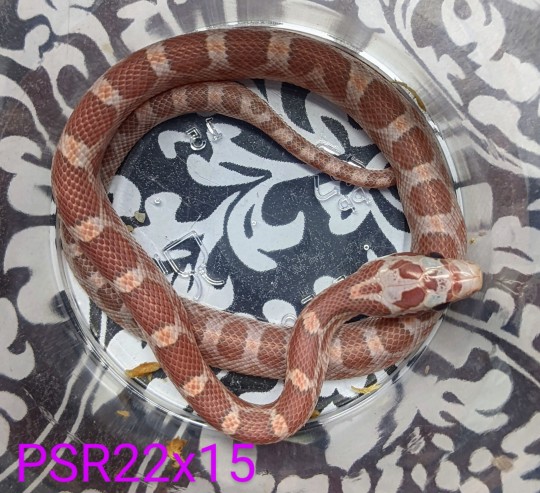

PSR22 is all out. This is the largest clutch for this year with 16 hatchlings! They are all Hypo Masque, Hypo Super Masque, and Hypo Diffused and about half of them are visually heterozygous for Peach but that's not quite visible yet. We'll inspect them in a shed or two and hopefully be better able to determine who's what.
In the meanwhile, they'll be busy learning how to be really real snakes!
#PSR22#snake#snakes#reptile#reptiles#reptiblr#corn snake morphs#hypo masque corn snake#hypo diffused corn snake#Peach Hypo corn snake#Peach Hypo Diffused corn snake#PSR22 ref#baby snake
49 notes
·
View notes
Text
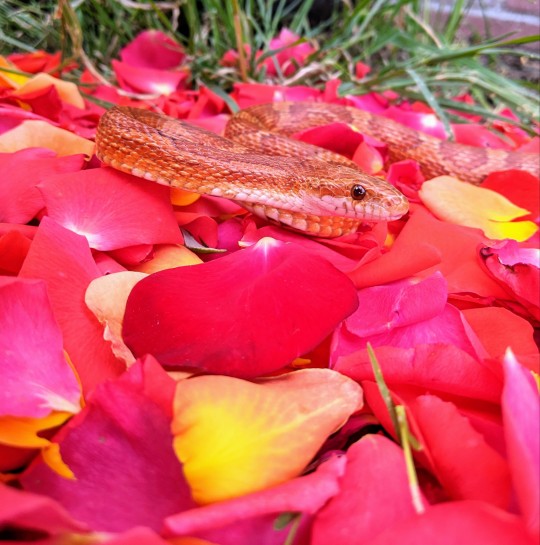
#snake#snakes#reptile#reptiles#reptiblr#corn snake#corn snakes#Carl#hypo corn snake#hypo masque corn snake
66 notes
·
View notes
Text
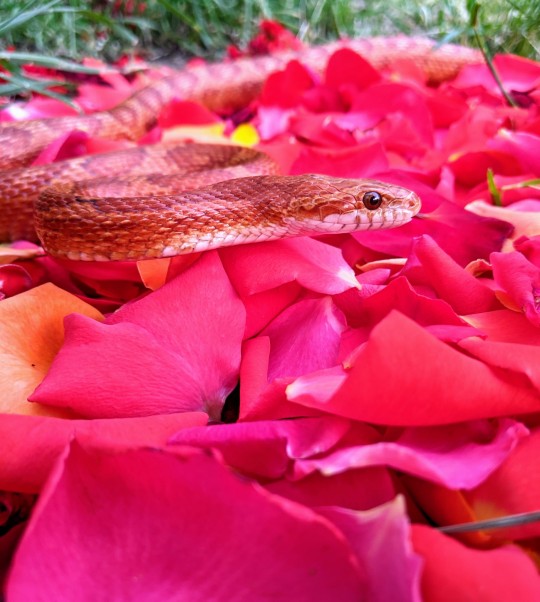
#carl#snake#snakes#reptile#reptiles#reptiblr#corn snake#corn snakes#hypo corn snake#hypo masque corn snake
62 notes
·
View notes
Note
In a recent clutch you posted you mentioned all the babies were masque, super masque or didn't have masque in them. Since there's all three in the clutch would you mind explaining what the masque gene does and how it varies in it's normal and super forms?
Oh you done did it now, friend. You went and asked the question. I hope you're ready for the answer because we're gonna get into it!
Masque is a hotly debated and poorly understood morph in general. What does it look like? How does it work? What does it even DO?
We'll dig in with the caveat that this is all still being explored and this information might change as we continue to gain understanding of the corn snake genome and how different genes express themselves.
I'll put this under a cut because y'all know by this point that I like to infodump and I don't want to pull a "Do You Love the Colour of the Snake?" on anybody.
So Masque came about because of the Bloodred morph. Bloodred was originally thought to be a single gene which caused pattern reduction, a white tummy, and deep brick red coloration. Breeders soon began to notice that outcrossing a Bloodred with another morph that was heterozygous for Bloodred was resulting in snakes with white tummies but not the same deep red, or pattern reduction on the head and tummy but not a solid white tummy! It was then that they began to realize that Bloodred was not a single gene but three genes being simultaneously expressed: Red Coat, a recessive red-enhancing trait; Diffused, a recessive pattern-reducing and belly checker-eliminating trait; and Masque, a dominant or possibly co-dominant trait which affects headstamp expression and causes an overall "brightening" color effect.
Since Diffused and Masque were discovered together, and Masque is a dominant trait, there's a really good chance that any Diffused snake is also displaying Masque. It's usually pretty easy to tell, just look at the headstamp! Let's take a look at Griswold, a Diffused Ghost corn snake. Here he is as a baby:

You can see how the pattern on his head is reduced to weird eyebrows and the patterning on his sides fades to just about nothing as it reaches his belly.
Here he is today:
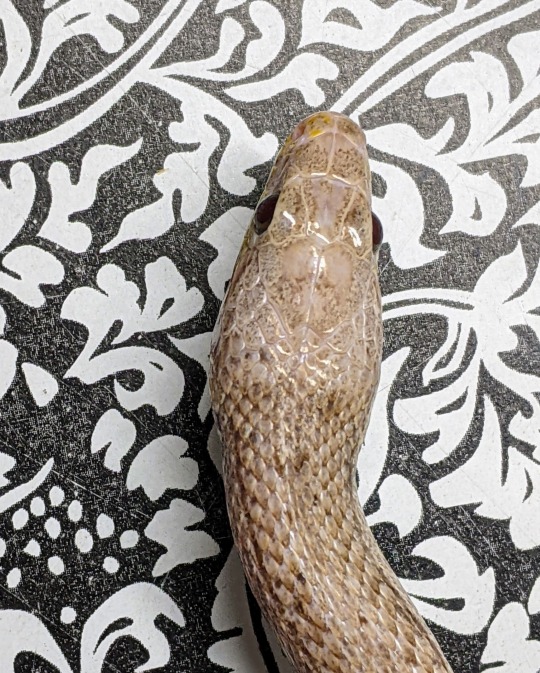
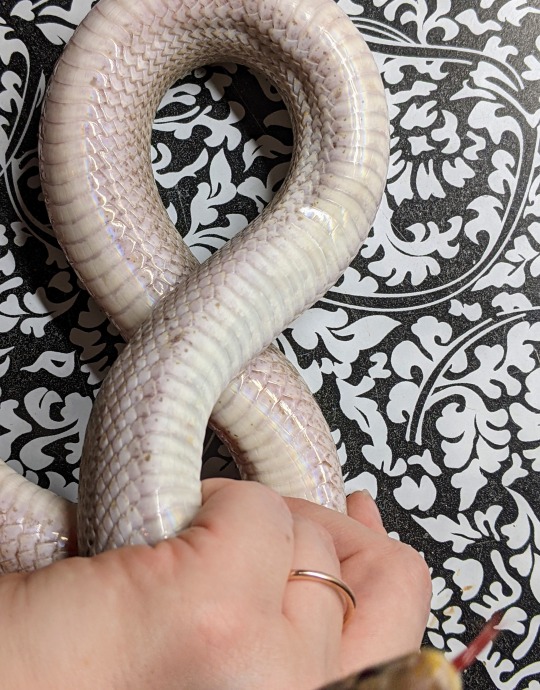
(Excuse the chubby tum, he just had dinner and was kind enough to indulge me messing with him a little bit)
As you can see, he is definitely Diffused with that solid white belly and he's also displaying the Masque trait with the severely reduced headstamp.
So how do we know a snake is Masque without Diffused?
Chammers is here to help us out! One thing Masque does is cause overall lightening/brightening of color on a snake. Here's baby Chammers with a sibling. Can you tell the difference?

It's subtle, but the lighter colored Anery snake on the right is Mrs. Chamamndler Bing himself. In this early stage of life, his headstamp is not significantly different from his non-Masque sibling. But look at what happened as he got older:
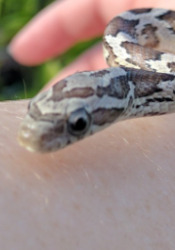
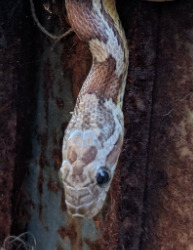
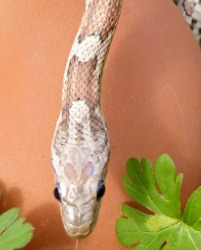
And that brings us to today:

That looks a lot more like what we expect from a Masque, right?
And if you weren't 100% sure that Chammers is indeed Masque, we can take a look at his tummy:
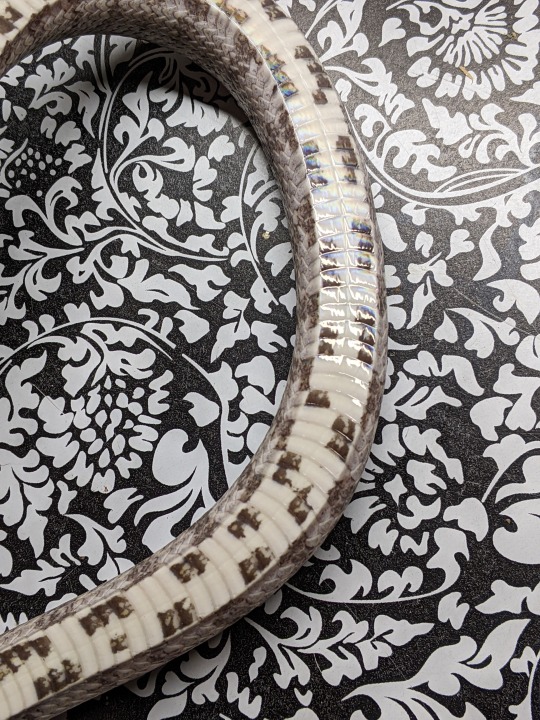
You'll note a white line between the checkers, almost creating an "open zipper" pattern. All masques will have this white line down the middle, and the line is wider for high-expression Masques. Chammers is heterozygous for Masque, meaning he has only one copy of the gene, so he has a 50/50 chance of passing the gene down to any offspring he sires.
Okay so what the heck is a Super Masque? Remember me saying that Masque is potentially co-dominant? This term refers to a dominant trait that expresses somewhat when heterozygous but expresses more or differently when homozygous. Palmetto is a really good example of a co-dominant trait. A het Palmetto looks almost hypomelanistic, with bright coloration and reduced melanin. They don't look the same as a Palmetto but they're a different visual phenotype than a classic corn snake. A hom Palmetto is leucistic (all white) with color sprinkles.
Where it gets hairy is when we ask how to tell the difference between Masque and Super Masque. Some breeders claim that you can tell because the belly checkers will be almost completely absent and the headstamp will be reduced to just tiny eyebrows, as in MA22M1 here:

(Who is diffused, by the way)
But I've seen enough snakes to not feel confident agreeing with that assessment. Case in point: Pumpkin Spice.
Pumpkin Spice was the result of two Masque parents. Every clutch she has laid has been 100% Masque babies. Look at her tummy as a baby:

The split of her belly checkers is so wide that she barely has any checkers at all! So she's almost definitely a Super Masque, right?
But look at that headstamp over the years. :/



Despite everything else pointing to her being homozygous for Masque, her headstamp looks positively Classic. If anything, it's gotten LESS Masque-y over time!
So my assessment? Masque is more likely a simple dominant trait with low or high expression. I don't think it's co-dominant and it would take some evidence I haven't seen yet to convince me. I do, however, find that it's helpful to use "Super" for dominant traits like Masque, Tessera, etc. to indicate that a baby is homozygous for the trait as this may affect breeding plans and/or pricing.
There you go! I hope you got the answer you were looking for and that this was helpful in demystifying the gene and explaining my personal take on the situation.
#I must note that Chammers got spooked BAD by my cell phone camera and flipped out#I had to calm him and let him sniff it like ten times#He really hated it but he was a total champ and very brave despite being quite terrified of the scary rectangle#He's never had that issue before#Afterward I calmed him and just held him for a bit and he was okay as long as I wasn't pointing the camera at him.#Poor Chammers!#Chammers#Mrs. Chamamndler Bing#Chamma lamma ding-dong#Griswold#The Grizz#Grizzled#Pumpkin Spice#Pumpkin Spice doesn't have any nicknames because she's a queen and you don't nickname a queen#Hypo Masque corn snake#Ghost Diffused corn snake#Anery Masque corn snake#snake#snakes#reptile#reptiles#reptiblr#corn snake#corn snakes#text post#answers to questions#oh i'm sorry did you want an answer here have a novel#thank you for coming to my ted talk.#corn snake morphs#corn snake breeding
27 notes
·
View notes
Text
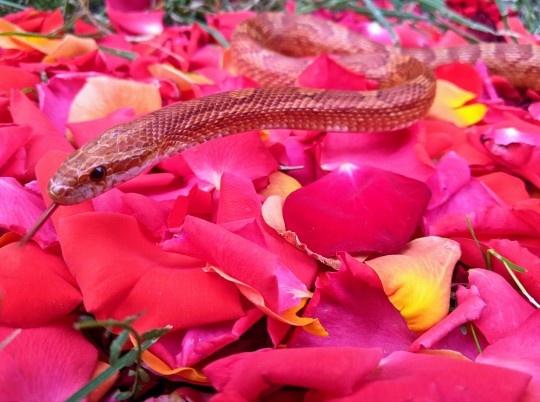
#Carl#snake#snakes#reptile#reptiles#reptiblr#corn snake#corn snakes#hypo corn snake#hypo masque corn snake
41 notes
·
View notes
Text

#Carl#snake#snakes#reptile#reptiles#reptiblr#corn snake#corn snakes#hypo corn snake#hypo masque corn snake
42 notes
·
View notes
Text

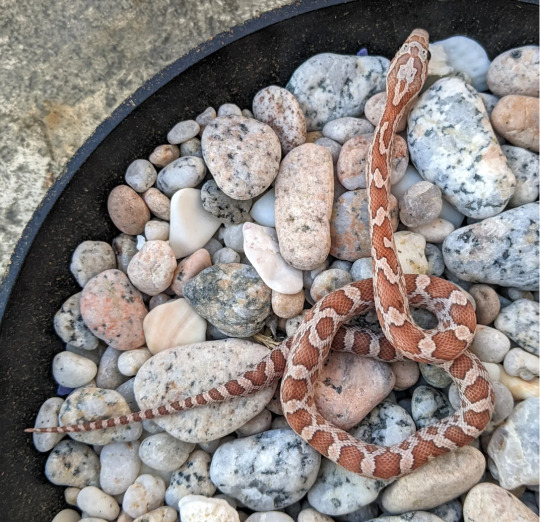

If you were thinking about a pet corn snake, and you'd love to have one that is very fancy but the prices on most high-end morphs are a tad intimidating, I have good news for you!
I currently have a trio of pet-only Lavender combo morphs available with free shipping. These kiddos are thriving and have great temperament, but they have minor spinal kinkage and should not be bred. Their kinks are not visible but they can be felt, and they don't impact their ability to do normal snake stuff like eating, drinking, burrowing, and climbing. They will grow into sweet and lovely companion animals.
Top to bottom, they are:
RR22M1 - Hypo Plasma Peach, male - $150 shipped*
RR22F6 - Lavender Masque, female - $150 shipped*
RR22M9 - Hypo Plasma Peach, male - $150 shipped*
to inquire, send me a message through Tumblr or email snakesomg (at) gmail.com
*shipping available within contiguous United States only
#snakes#snake#RR22#snakes for sale#available snakes#corn snake#corn snakes#baby snake#lavender masque corn snake#hypo plasma peach corn snake#reptile#reptiles#reptiblr
56 notes
·
View notes
